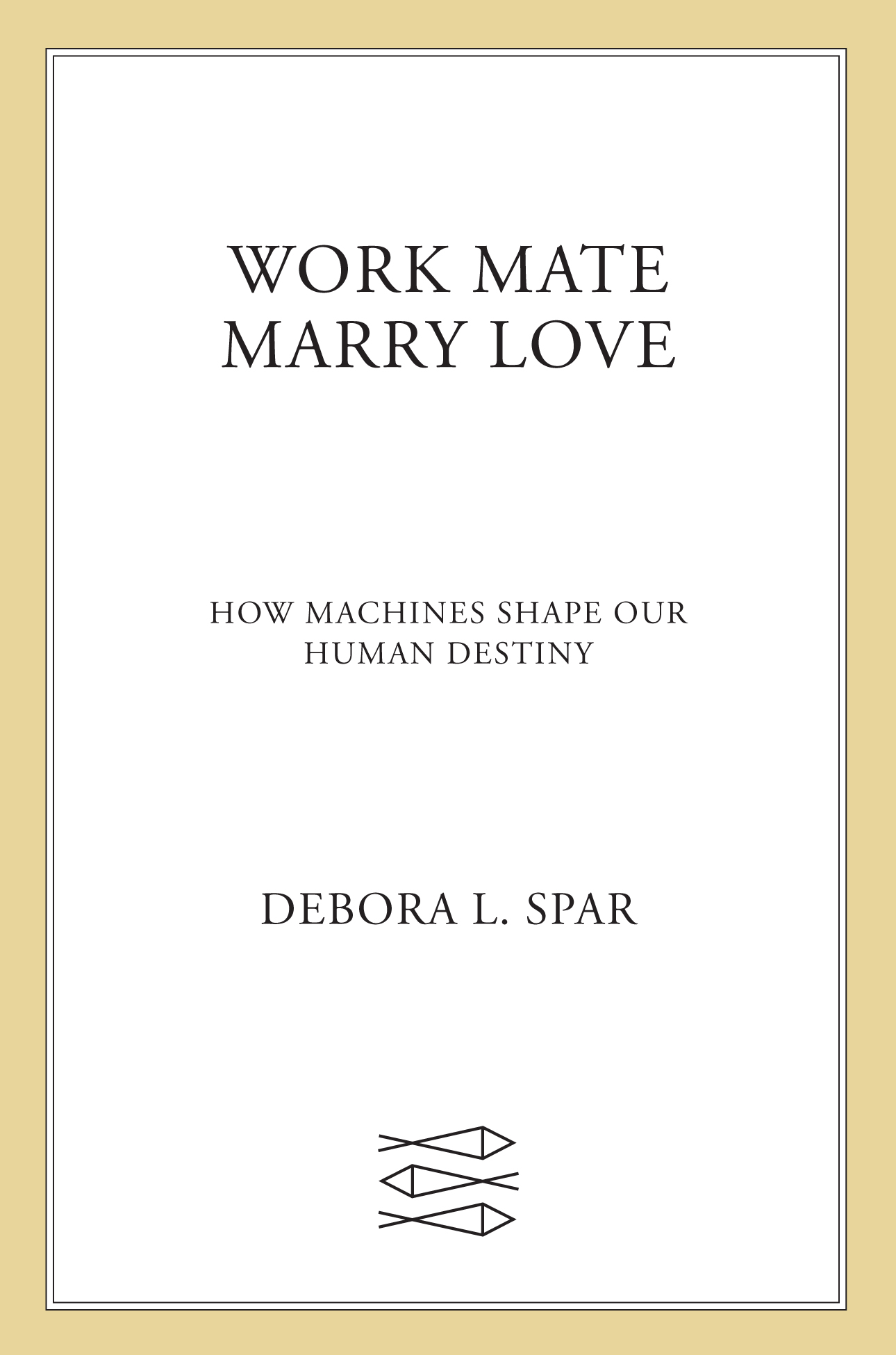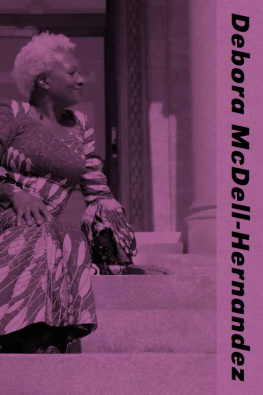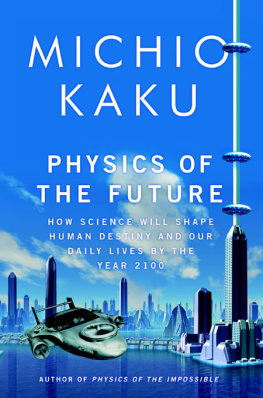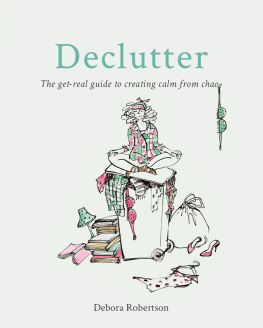Debora L. Spar - Work Mate Marry Love: How Machines Shape Our Human Destiny
Here you can read online Debora L. Spar - Work Mate Marry Love: How Machines Shape Our Human Destiny full text of the book (entire story) in english for free. Download pdf and epub, get meaning, cover and reviews about this ebook. genre: Home and family. Description of the work, (preface) as well as reviews are available. Best literature library LitArk.com created for fans of good reading and offers a wide selection of genres:
Romance novel
Science fiction
Adventure
Detective
Science
History
Home and family
Prose
Art
Politics
Computer
Non-fiction
Religion
Business
Children
Humor
Choose a favorite category and find really read worthwhile books. Enjoy immersion in the world of imagination, feel the emotions of the characters or learn something new for yourself, make an fascinating discovery.

- Book:Work Mate Marry Love: How Machines Shape Our Human Destiny
- Author:
- Genre:
- Rating:3 / 5
- Favourites:Add to favourites
- Your mark:
- 60
- 1
- 2
- 3
- 4
- 5
Work Mate Marry Love: How Machines Shape Our Human Destiny: summary, description and annotation
We offer to read an annotation, description, summary or preface (depends on what the author of the book "Work Mate Marry Love: How Machines Shape Our Human Destiny" wrote himself). If you haven't found the necessary information about the book — write in the comments, we will try to find it.
Debora L. Spar: author's other books
Who wrote Work Mate Marry Love: How Machines Shape Our Human Destiny? Find out the surname, the name of the author of the book and a list of all author's works by series.
Work Mate Marry Love: How Machines Shape Our Human Destiny — read online for free the complete book (whole text) full work
Below is the text of the book, divided by pages. System saving the place of the last page read, allows you to conveniently read the book "Work Mate Marry Love: How Machines Shape Our Human Destiny" online for free, without having to search again every time where you left off. Put a bookmark, and you can go to the page where you finished reading at any time.
Font size:
Interval:
Bookmark:


The author and publisher have provided this e-book to you for your personal use only. You may not make this e-book publicly available in any way. Copyright infringement is against the law. If you believe the copy of this e-book you are reading infringes on the authors copyright, please notify the publisher at: us.macmillanusa.com/piracy.
To the memory of Mary Margaret Winifred Billington,
whose indomitable spirit endures
First we build the tools, then they build us.
Marshall McLuhan
The future of the past was a bright and shiny thing.
In 1851, when Britains Prince Albert triumphantly opened his countrys Great Exhibition in the Crystal Palace, he saw it as representing an inflection point in history, a moment when humankind would come together to praise the marvels of technologyengines and looms and printing machineryand contemplate the wonders ahead. The exhibition took place in a castle made of glass, three hundred thousand sheets of the largest expanses of glass ever made, plus spans of cast-iron columns and a massive curved roof hovering above a canopy of live trees. It was an Arabian Nights structure a splendid phantasm, a glimpse of a future that had just been born.
Fast-forward now to the Worlds Fair of 1964, hosted by an America bursting with progress and eager to revel in the joys of tomorrow. Like its Victorian predecessor, the 1964 fair was organized by local luminaries and dedicated, ostensibly, to peace, understanding, and the advent of technology. But it was technology that really stole the show again, captivating visitors with its seductive vision of what the future would bring. There were films from IBM on the inner workings of computers, and an array of full-scale rocket models. There was a Picturephone, conveying callers images along with their voices. There were lunar colonies and microwave ovens and cars that could travel through space. In the Festival of Gas pavilion, a Norge Dish Maker washed the family of the futures plastic dinnerware, and then ground it into pellets that could be transformed into new plates and saucers.
The funny thing about the future, though, is how new it actually is. Until recently, after all, humans couldnt really imagine a future that was any different from the past. For thousands and thousands of years, across every corner of the world, people lived more or less as their parents and grandparents had. Individuals faced the tiny details of their fatethe person theyd mate with and the children they bore; the length of their lives and the way they diedbut their lives in a broader sense would unfurl across the exact same landscape as their ancestors. The same modes of transportation. The same kinds of homes. The same ways of sowing and reaping and praying for rain. When nothing changed from year to year, the very idea of the future was inconceivable.
It was technology that changed this world, and created a future that was different from the past. Because once technology crashed into peoples livesonce it upended the age-old ways of farming or building or movingpeople living through any particular moment in time could imagine later moments that were different, and better. People could imagine change and progress, a world ahead that was differentfaster, sleeker, sexier, richerthan what they had always known. They could begin to dream of that future, and conceive the tools that would roust it into being.
In dreaming of this shiny future, though, we humans have demonstrated an uncanny knack for compartmentalization, neatly dividing our workaday selves from our more intimate identities. When we think about technology, we think about machines. Steam engines and spinning looms in Prince Alberts day, robots and drones and driverless cars in ours. And when we think about our future selves, we presume that our tools will change, but not the inner currents of our lives. In other words, even when the pace of technological change is racing and accelerating, even when we can easily glimpse a future marked by artificial intelligence and casual rides to Mars, we still somehow imagine that weas a species and as individualswill remain largely the same. That well have sex and fall in love; marry, bear children, and die. That well live amid the bright and shiny tools of technology, but not be altered by them in any fundamental way.
It is tempting to feel this way, and to imagine a future that feels much like the pastsame families, same yearnings, same mixed-up relationships and enduring loves. But this just cant be right. Because as technology changes, it is going to change us as well. Indeed, it already has.
In particular, the technologies of the twenty-first century are already beginning to hammer away at what have long been the contours of our romantic and family lives. How we fall in love. How we have sex and bear children. How we think, at the most basic level, of our bodies and ourselves. The old normalthe normal that endured for so long that we presumed it to be eternalis already starting to morph and evolve, paving the way toward a fundamentally reconfigured future.
Lets start with the most basic foundation of family life: babies. It used to be that they were born through standard, predictable channelscreated by one man and one woman, usually living together in a legally sanctioned union known as marriage. This was the structure that surrounded and legitimized the inherently human act of reproduction, the structure that was celebrated, blessed, and repeated endlessly across nearly all the worlds developed societies. Although marriage has never been a biological prerequisite for babies, it hasfor agesbeen the context that surrounds them, a context so prevalent and pervasive as to feel carved in stone.
But its not. In fact, in the course of less than fifty years, the norms of marriage and baby-making have already undergone a seismic set of changes. In 2015, nearly half the children in the United States were living in nontraditional households, and 40 percent of births were to unmarried womenup from only 5 percent in 1960. In South America, likewise, more than half of all children are currently born to unmarried mothers, as are between one-third and one-half of children in western Europe. Across the Western world, as a result, the nuclear family is the norm in a declining number of households, replaced by a growing hodgepodge of single-parent households, cohabiting adults, and extended stepparenting arrangements.
Outside the family structure, similarly radical changes are transforming sex and gender and love. Same-sex marriagevirtually unimaginable as recently as fifty years agohas surged from the shadows to become both acceptable and celebrated, and gay weddings now regularly grace the pages of most metropolitan newspapers. Gay couples are having and adopting children in numbers that would have been literally inconceivable just a few decades earlier, and children, regardless of their parentage, are increasingly being hatched from a growing array of high-technology means: donor sperm, donor eggs, frozen eggs and embryos. Some of these children, moreoversome of the generation born around the turn of the new millenniumare also deciding as they grow up to transition from one gender to another, transforming their own bodies in the process, along with societys long-standing notions of sex and gender and identity.
As these changes have rocketed through the worlds social infrastructure so, too, have technological innovations been changing the face of industry and commerce. Smartphones, 3D printing, the entire Uber-centric economy of a technology-enabled transient labor forcethey all burst into commercial prominence between 2000 and 2015, heralding a new machine age and delivering vast wealth to those along its cutting edge. No one knows, really, how these technologies will evolve over time, and how they will shape the workplace and workforce of the future. But we know the changes will be vast, and their impactlike that of most technological revolutionsprofound.
Font size:
Interval:
Bookmark:
Similar books «Work Mate Marry Love: How Machines Shape Our Human Destiny»
Look at similar books to Work Mate Marry Love: How Machines Shape Our Human Destiny. We have selected literature similar in name and meaning in the hope of providing readers with more options to find new, interesting, not yet read works.
Discussion, reviews of the book Work Mate Marry Love: How Machines Shape Our Human Destiny and just readers' own opinions. Leave your comments, write what you think about the work, its meaning or the main characters. Specify what exactly you liked and what you didn't like, and why you think so.









